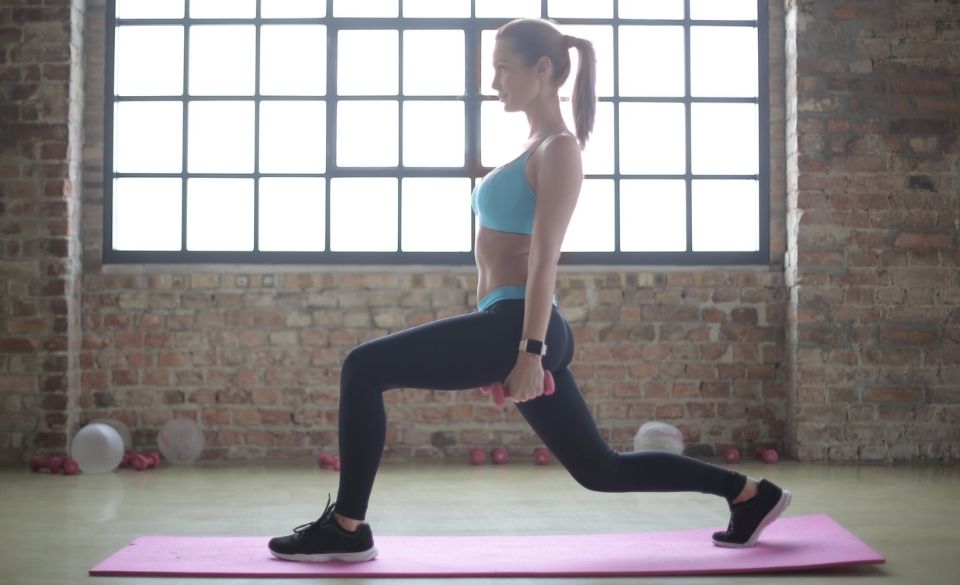
How to Do Lunges for Beginners: Improve Your Strength and Balance
Page Contents
Discover the correct way to perform lunges and supercharge your lower body strength exercises. Understanding the proper technique for lunges can unlock a diverse array of options for enhancing your lower body strength. Runners, in particular, stand to gain substantial benefits from lunges. They effectively target your glutes, enhance your balance, and contribute to improved running form while lowering the risk of running-related injuries. In this article, you’ll find out how to perform beginner lunges
If you’re looking to elevate your workout intensity, or if you’re already an intermediate fitness enthusiast, consider incorporating dumbbells for an added challenge.
Lunge Fundamentals
When performing lunges, maintaining proper form is essential. This not only prevents injuries and undue stress on your knees or back but also ensures that you’re effectively engaging the targeted muscle groups.
How to Execute Lunges
Here’s a detailed, step-by-step guide on how to perform lunges:
1. Start by standing with your feet close together, chest up, and shoulders pulled back.
2. Take a step forward with one leg, lowering your body toward the floor, and bending both knees at approximately a 45-degree angle.
3. Descend until your back leg is just a few inches from the ground, with your front thigh parallel to the floor. Keep your core muscles engaged throughout.
4. Push back up to return to your initial position, with both feet together. Now, repeat the entire sequence with the other leg.
Lunge Pointers
To make the most of your lunges, consider these key tips:
1. Slight Forward Lean: While lunging, leaning forward ever so slightly can alleviate pressure on your front knee.
2. Posture and Engagement: Maintain an upright chest and keep your core muscles actively engaged. As you raise and lower your body, remember to squeeze your glutes. If needed for balance, a minor forward lean is acceptable. Visualize your body moving straight up and down.
3. Knee Position: Ensure that your knee does not extend beyond your ankle as you bend your front leg. Aim for a 90-degree angle when lowering yourself into the lunge; this technique helps reduce stress on your knees.
4. Hand Placement: If it helps you maintain balance, you can place your hands on your hips. For a more advanced variation, consider holding dumbbells during your lunges.
5. Boosting Glute Workout: According to the National Academy of Sports Medicine, incorporating a slight forward lean during lunges can not only reduce pressure on the front knee but also intensify the workout for your glute muscles.
Benefits of Incorporating Lunges
Discover the numerous advantages of integrating lunges into your fitness routine. Lunges are a versatile exercise suitable for individuals of all fitness levels, making them an excellent choice. Here’s what you can gain from adding lunges to your regimen:
1. Glute Strengthening: Lunges are a highly effective workout for strengthening your glutes. They also engage other major muscle groups, including your quads, hamstrings, calves, hips, and core muscles.
2. Address Weak Glutes: Many runners, and even individuals in general, tend to have underdeveloped glute muscles. Lunges can significantly contribute to rectifying this issue. Weak glutes often lead to strain on other compensating muscles, such as the hamstrings, which can result in running-related injuries. By strengthening your glutes, you enhance your running speed, bolster your balance, and elevate your performance across various sports and fitness activities.
3. Core Stability: Lunges play a role in stabilizing your core and activating your abdominal muscles. This added engagement in the abdominal region strengthens your core, leading to improved posture, balance, and running form.
4. Enhanced Hip Strength: Lunges also work on strengthening your hip muscles. As you perform lunges, your hips move in an up-and-down motion, contributing to better hip stability.
Incorporating lunges into your exercise routine provides a wide range of benefits, from strengthening various muscle groups to enhancing your overall performance and injury prevention.
Adapting Lunges to Your Needs
Before embarking on lunges, especially if you have preexisting knee concerns, it’s advisable to consult with your healthcare provider. It’s crucial to prioritize your safety and well-being.
For those seeking a lower-impact lunge option, the beginner’s lunge depicted in the video can be a favorable choice. This variation involves starting with one foot forward and does not entail stepping into the lunge. Instead, you lower your body up and down while keeping your feet firmly planted. Back lunges are another variation that places less stress on the knees compared to standard front lunges.
If you are new to lunges or exercise in general, it’s advisable to commence with the basic lunge form. In this variation, your feet remain stationary as you raise and lower your body. As you progress and build both balance and strength, you can explore more advanced lunge variations.
As a valuable recommendation, I encourage runners to incorporate lateral (side) lunges into their routine. These movements target muscles that play a pivotal role in stabilizing your body while running. Since running predominantly occurs in a forward-backward plane, these lateral movements often remain underdeveloped. By adding side lunges, you can address this muscular imbalance and further enhance your running performance.
How Many Lunges Should You Do?
The ideal number of lunges to incorporate into your routine varies from person to person. Generally, it’s advisable to allow your body at least a day of rest between strength training sessions. With that in mind, I recommend integrating lunges into your routine two to three times a week, particularly if you’re incorporating dumbbells or weights into your lunges.
If you’re just beginning, start with a few lunges while prioritizing good form. Gradually, work your way up to performing sets of 10 to 15 lunges. Once you can maintain proper form consistently, aim to complete a set of 10 to 15 lunges, and repeat this for a total of three sets. As you become more accustomed to lunges and refine your form, you’ll notice that they become more manageable. In time, you can increase the intensity of your strength training by introducing dumbbells or additional weights into your lunge routine.
Strength Training and Protein Intake
Incorporating weights into your lunge exercises, especially if you’re engaged in additional weightlifting routines, necessitates a balanced protein intake to support muscle recovery and development. The National Academy of Sports Medicine provides these protein consumption recommendations for active adults:
For endurance-trained individuals (defined as those who engage in over 10 hours per week of endurance-type training):
Aim for 2 to 1.4 grams per kilogram of body weight (0.55 – 0.64 grams per pound).
For strength-trained individuals:
Target 4 to 2.0 grams per kilogram of body weight (0.64 – 0.91 grams per pound).
A useful guideline is to consume 20 to 30 grams of protein within 30 minutes following your strength training session. This practice facilitates muscle recovery and ensures you reap the full fitness benefits of your lower body workout.
When to Include Lunges in Your Routine
Lunges can be effectively incorporated into your fitness regimen on base run days when your body isn’t fatigued from intense workouts or speed training. If you wish to include weighted lunges in your routine on high-intensity running days, it’s crucial to allow a minimum of 5 hours of rest after your run before embarking on your leg workout.
However, avoid performing weighted lunges on your rest or recovery days, as lunges qualify as a form of strength training, which is categorized as a rigorous training session. You can also include bodyweight lunges as part of your dynamic warm-up before a speed workout or training run. For a more comprehensive calorie-burning and toning workout that complements your running routine, consider integrating burpees into your lunge routine.
Final Words – How to Do Lunges for Beginners
In conclusion, mastering the art of lunges is an invaluable addition to your lower body strength exercises. Not only do they offer an array of variations to enhance your strength, but they also provide substantial benefits for runners by targeting the glutes, improving balance, and reducing the risk of running-related injuries. If you’re up for the challenge, incorporating dumbbells can add a new dimension to your lunges.
Remember the fundamentals of maintaining proper form during lunges, including a slight forward lean, good posture, knee positioning, and glute engagement. These key pointers will help you make the most of your lunge workouts while keeping you safe and injury-free.
The benefits of integrating lunges into your fitness routine are diverse, from strengthening various muscle groups to enhancing your overall performance and injury prevention. Don’t forget to adapt your lunge routine to your specific needs and consider seeking professional advice if you have preexisting knee concerns.
As for the question of how many lunges to do, it varies from person to person. To get started, aim for sets of 10 to 15 lunges, gradually building your way up. Proper form is the priority, and as you improve, you can increase the intensity with weights.
Lastly, when you incorporate weights into your lunges or engage in additional strength training exercises, be mindful of your protein intake. Following your strength training session, consume 20 to 30 grams of protein within 30 minutes to support muscle recovery and growth.
Timing your lunge workouts is crucial. Base run days are ideal, ensuring your body isn’t overly fatigued. Give yourself at least 5 hours of rest after high-intensity running before engaging in weighted lunges. Avoid incorporating weighted lunges on rest or recovery days, as they qualify as rigorous strength training sessions.
For a full-body, calorie-burning, and toning workout that complements your running routine, consider adding burpees to your lunge routine. Lunges can be a game-changer in your fitness journey, whether you’re a beginner looking to improve strength and balance or an experienced fitness enthusiast aiming for an added challenge.



